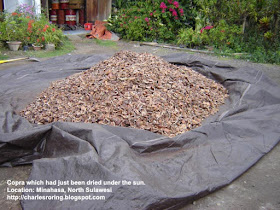by Charles Roring
 |
| Coconut Fruits |
In tropical areas, copra has been a traditional commodity for the villagers. Copra is the white flesh of a coconut (endosperm) which has been dried. When it is in dry form its color changes into dark brown. Farmers usually pick up the fallen coconuts in their garden.
After peeling of the coconut and cracking the hard shell which covers the endosperm, the farmer or copra worker will pry loose the meat of the coconut. Then he will dry all the endosperm under the sun. Sometimes the weather is cloudy and the optimum drying of copra cannot be achieved. To accelerate the drying process, farmers roast the hundreds of kilograms of endosperms by using shell and husk that are the byproducts of the coconut.
In intensive coconut plantation, the harvest is carried out every two or three months. For 9,000 up to 11,000 coconuts, a farmer can get between 1.5 and 2.0 metric ton of copra. One hectare of coconut trees can produce between 5,000 and 6,000 coconuts a year. They are equal to around 1.5 ton of Copra. One ton equals to 1,000 kilograms.
In the past, oil that was obtained after pressing the copra was used as edible or cooking oil. It was not competitive to make it as bio-fuel. Yesterday (16 June, 2008), the price of crude oil reached 140 US
 |
| Kopra (dried coconut meat) |
Coconut can produce sap which can be processed to make bio-ethanol. Before its blossom (spadix) changes into coconut fruits, a farmer cut it and collect its sap in a bamboo. Traditionally the sap is boiled to make palm sugar.
Besides coconut, there is also another palm variety that produces higher amount of sap. It is Saguer palm tree. It looks like coconut but they are different. Saguer tree is the local name of Arenga Pinnata (Latin) in Minahasa regency in the Province of North Sulawesi. When I travelled to this region, I was able to take pictures of the Saguer tree. For other region in Indonesia
 |
| Aren tree |
Saguer produces sweet sap which ferments fast. For palm sugar home industry, the container (usually bamboo) has to be washed to clean the yeast formed or produced by the saguer tree itself. The color of the sap or the juice is clear white. It is then boiled and stirred using small flame to make palm sugar. I haven't been able to present data about the production capacity for a hectare of saguer trees. Fermented Saguer sap contain alcohol which can be distilled to make bio-ethanol. This alcoholic drink has been banned in Manokwari, West Papua due to its negative effect in the community. Drunkards which drink the Saguer or Ampo often committed violence in the market or in their neighborhood. The utilization of saguer sap into bio-fuel can be considered as a positive alternative for traditional farmers.
So, in order to make bio-fuel, we do not have to depend on Sawit palm tree (Elaeis guineensis) which in certain regions of tropical areas are not a native palm variety. We can still produce bio-fuel by using native plants that will not severely damage the surrounding local environment.
No comments:
Post a Comment